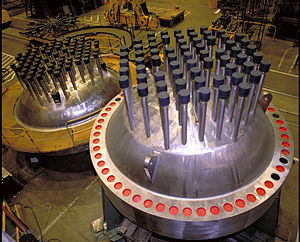
Back مفاعل الماء المضغوط Arabic Вода-вадзяны ядзерны рэактар Byelorussian Вода-вадзяны ядзерны рэактар BE-X-OLD চাপযুক্ত জল চুল্লি Bengali/Bangla Reactor d'aigua pressuritzada Catalan Tlakovodní reaktor Czech Druckwasserreaktor German Αντιδραστήρας πεπιεσμένου ύδατος Greek Premakva reaktoro Esperanto Reactor de agua a presión Spanish
A pressurized water reactor (PWR) is a type of light-water nuclear reactor. PWRs constitute the large majority of the world's nuclear power plants (with notable exceptions being the UK, Japan, India and Canada).
In a PWR, water is used both as a neutron moderator and as coolant fluid for the reactor core. In the core, water is heated by the energy released by the fission of atoms contained in the fuel. Using high pressure (around 155 bar) ensures that the water stays in a liquid state. The heated water then flows to a steam generator, where it transfers its thermal energy to the water of a secondary cycle kept at a lower pressure which allows it to vaporize. The resulting steam then drives steam turbines linked to an electric generator. A boiling water reactor (BWR) by contrast does not maintain such a high pressure in the primary cycle and the water thus vaporizes inside of the reactor pressure vessel (RPV) before being sent to the turbine. Most PWR designs make use of two to six steam generators each associated with a coolant loop.
PWRs were originally designed to serve as nuclear marine propulsion for nuclear submarines and were used in the original design of the second commercial power plant at Shippingport Atomic Power Station.
PWRs are operated in the United States, France, Russia, China, South Korea and several other countries. The majority are Generation II reactors; newer Generation III PWR designs such as the AP1000, Hualong One, EPR and APR-1400 have entered service from 2018.
